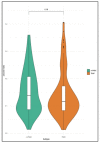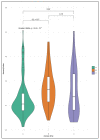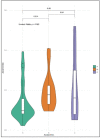Single-Cell NGS-Based Analysis of Copy Number Alterations Reveals New Insights in Circulating Tumor Cells Persistence in Early-Stage Breast Cancer
- PMID: 32887501
- PMCID: PMC7565733
- DOI: 10.3390/cancers12092490
Single-Cell NGS-Based Analysis of Copy Number Alterations Reveals New Insights in Circulating Tumor Cells Persistence in Early-Stage Breast Cancer
Abstract
Circulating tumor cells (CTCs) are a rare population of cells representing a key player in the metastatic cascade. They are recognized as a validated tool for the identification of patients with a higher risk of relapse, including those diagnosed with breast cancer (BC). However, CTCs are characterized by high levels of heterogeneity that also involve copy number alterations (CNAs), structural variations associated with gene dosage changes. In this study, single CTCs were isolated from the peripheral blood of 11 early-stage BC patients at different time points. A label-free enrichment of CTCs was performed using OncoQuick, and single CTCs were isolated using DEPArray. Libraries were prepared from single CTCs and DNA extracted from matched tumor tissues for a whole-genome low-coverage next-generation sequencing (NGS) analysis using the Ion Torrent S5 System. The analysis of the CNA burden highlighted that CTCs had different degrees of aberration based on the time point and subtype. CTCs were found even six months after surgery and shared CNAs with matched tumor tissue. Tumor-associated CNAs that were recurrent in CTCs were patient-specific, and some alterations involved regions associated with BC and survival (i.e., gains at 1q21-23 and 5p15.33). The enrichment analysis emphasized the involvement of aberrations of terms, associated in particular with interferon (IFN) signaling. Collectively, our findings reveal that these aberrations may contribute to understanding the molecular mechanisms involving CTC-related processes and their survival ability in occult niches, supporting the goal of exploiting their application in patients' surveillance and follow-up.
Keywords: CNA; CTCs; NGS; breast cancer; liquid biopsy; single-cell analysis.
Conflict of interest statement
The authors declare no conflict of interest.
Figures




References
LinkOut - more resources
Full Text Sources

